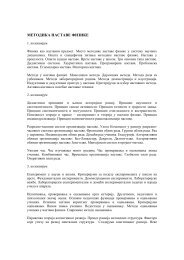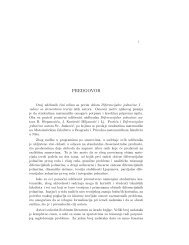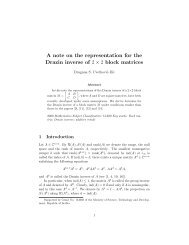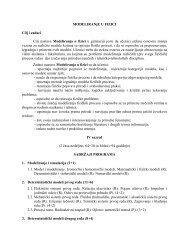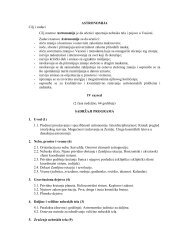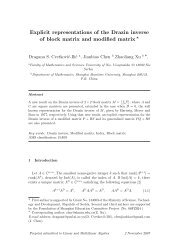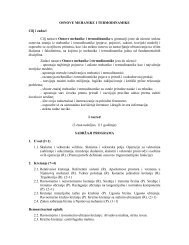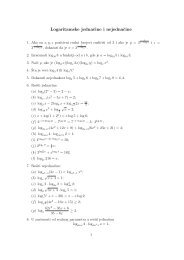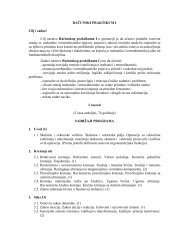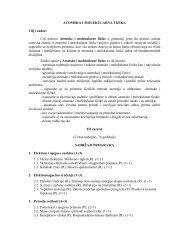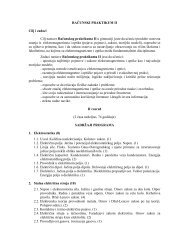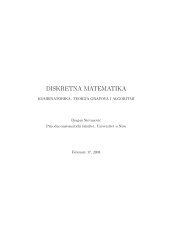The Hankel Transform of the Sum of Consecutive Generalized ...
The Hankel Transform of the Sum of Consecutive Generalized ...
The Hankel Transform of the Sum of Consecutive Generalized ...
You also want an ePaper? Increase the reach of your titles
YUMPU automatically turns print PDFs into web optimized ePapers that Google loves.
<strong>The</strong> <strong>Hankel</strong> <strong>Transform</strong> <strong>of</strong> <strong>the</strong> <strong>Sum</strong> <strong>of</strong><strong>Consecutive</strong> <strong>Generalized</strong> Catalan NumbersPredrag Rajković, Marko D. Petković,University <strong>of</strong> Niš, Serbia and Montenegroe-mail: pedja.rajk@gmail.com, dexter<strong>of</strong>nisgmail.comPaul BarrySchool <strong>of</strong> Science, Waterfall Institute <strong>of</strong> Technology, Irelande-mail: pbarry@wit.ieAbstract. We discuss <strong>the</strong> properties <strong>of</strong> <strong>the</strong> <strong>Hankel</strong> transformation <strong>of</strong> a sequencewhose elements are <strong>the</strong> sums <strong>of</strong> consecutive generalized Catalan numbers.1. IntroductionLet A = {a 0 , a 1 , a 2 , ...} be a sequence <strong>of</strong> real numbers. <strong>The</strong> <strong>Hankel</strong> matrix generatedby A is <strong>the</strong> infinite matrix H = [h i,j ], where h i,j = a i+j−2 , i.e.,⎡H =⎢⎣a 0 a 1 a 2 a 3 ...a 1 a 2 a 3 a 4 ...a 2 a 3 a 4 a 5 ...a 3 a 4 a 5 a 6 ...a 4 a 5 a 6 a 7 .......⎤⎥⎦.. .<strong>The</strong> <strong>Hankel</strong> matrix H n <strong>of</strong> order n is <strong>the</strong> upper-left n × n submatrix <strong>of</strong> H and<strong>the</strong> <strong>Hankel</strong> determinant <strong>of</strong> order n <strong>of</strong> A, denoted by h n , is <strong>the</strong> determinant <strong>of</strong> <strong>the</strong>corresponding <strong>Hankel</strong> matrix.For a given sequence A = {a 0 , a 1 , a 2 , ...}, <strong>the</strong> <strong>Hankel</strong> transform <strong>of</strong> A is <strong>the</strong> correspondingsequence <strong>of</strong> <strong>Hankel</strong> determinants {h 0 , h 1 , h 2 , . . . } (see Layman [?]).<strong>The</strong> elements <strong>of</strong> <strong>the</strong> sequence in which we are interested are <strong>the</strong> sums <strong>of</strong> twoadjacent generalized Catalan numbers with parameter L:a n = a n (L) = c(n; L) + c(n + 1; L) (n = 0, 1, 2, . . .), (2)c(n; L) = T (2n, n; L) − T (2n, n − 1; L), (3)1(1)
2with∑n−k( )( )k n − kT (n, k; L) =L j . (4)j jj=0Herea 0 = L + 1. (5)Example 1.1. Let L = 1. Vandermonde’s convolution identity implies that( n=k)∑ ( )( )k n − k.j jjHence we haveT (2n, n; 1) =wherefrom we get Catalan numbers( ) 2nc(n) = −nanda n = c(n) + c(n + 1) =( )( )2n 2n, T (2n, n − 1; 1) = ,n n − 1( ) 2n= 1 ) 2nn − 1 n + 1(n(2n)!(5n + 4)n!(n + 2)!(n = 0, 1, 2, . . .).In <strong>the</strong> paper [?] <strong>the</strong> authors have proved that <strong>the</strong> <strong>Hankel</strong> transform <strong>of</strong> a n equalssequence <strong>of</strong> Fibonacci numbers with odd indices1h n = F 2n+1 = √{( √ 5 + 1)(3 + √ 5) n + ( √ 5 − 1)(3 − √ }5) n .5 2n+1Example 1.2. For L = 2 we get like a n (2) <strong>the</strong> next numbersand <strong>the</strong> <strong>Hankel</strong> transform h n :One <strong>of</strong> us, P. Barry conjectured thath n (2) = 2 n2 −n2 −23, 8, 28, 112, 484, . . . ,3, 20, 272, 7424, 405504, . . . .{(2 + √ 2) n+1 + (2 − √ 2) n+1 }.In general, he made <strong>the</strong> conjecture, which we will prove through this paper.<strong>The</strong>orem 1.1. (<strong>The</strong> main result) For <strong>the</strong> generalized Pascal triangle associatedto <strong>the</strong> sequence n ↦→ L n , <strong>the</strong> <strong>Hankel</strong> transform <strong>of</strong> <strong>the</strong> sequencec(n; L) + c(n + 1; L)
3is given by−n)/2h n =L(n2 2 n+1√ L 2 + 4·{( √ L 2 + 4 + L)( √ L 2 + 4 + L + 2) n + ( √ L 2 + 4 − L)(L + 2 − √ }L 2 + 4) n .(6)From now till <strong>the</strong> end, let us denote byNow, we can writeξ = √ L 2 + 4, t 1 = L + 2 + ξ, t 2 = L + 2 − ξ. (7)h n = Ln(n−1)/22 n+1 ξ· ((ξ + L)t n 1 + (ξ − L)t n 2) . (8)Or, introducingϕ n = t n 1 + t n 2, ψ n = t n 1 − t n 2 (n ∈ N 0 ), (9)<strong>the</strong> final statement can be expressed byh n = Ln(n−1)/22 n+1 ξ· (Lψ n + ξϕ n ) . (10)Lemma 1.1. <strong>The</strong> values ϕ n and ψ n satisfy <strong>the</strong> relationsandϕ j · ϕ k = ϕ j+k + (4L) j ϕ k−j , ψ j · ψ k = ϕ j+k − (4L) j ϕ k−j (0 ≤ j ≤ k) (11)ϕ j · ψ k = ψ j+k + (4L) j ψ k−j , ψ j · ϕ k = ψ j+k − (4L) j ψ k−j (0 ≤ j ≤ k). (12)Corollary 1.1. <strong>The</strong> function h n = h n (L) is <strong>the</strong> next polynomialh n (L) = 2 −n L n(n−1)/2⎧⎨[(n−1)/2]∑·⎩i=0( n2i+1)L(L + 2) n−2i−1 (L 2 + 4) i +[n/2]∑i=0⎫( n) ⎬2i (L + 2) n−2i (L 2 + 4) i ⎭ .
4Pro<strong>of</strong>. By previous notation, we can write(L + ξ)(L + 2 + ξ) n − (L − ξ)(L + 2 − ξ) nn∑ (= (L + ξ) n)n∑k (L + 2) n−k ξ k − (L − ξ) (−1) k( )nk (L + 2) n−k ξ k== 2n∑k=0k=0(1 − (−1)k )( nk)L(L + 2) n−k ξ k +[(n−1)/2]∑i=0⎧⎨= 2ξ⎩∑[(n−1)/2]i=0n∑k=0( n2i+1)L(L + 2) n−2i−1 ξ 2i+1 + 2( n2i+1)L(L + 2) n−2i−1 ξ 2i +k=0( )( )1 + (−1)k nk (L + 2) n−k ξ k+1[n/2]∑i=0[n/2]∑wherefrom immediately follows <strong>the</strong> expression for h n .✸k=0i=02. <strong>The</strong> generating function( n2i)(L + 2) n−2i ξ 2i+1⎫( n) ⎬2i (L + 2) n−2i ξ 2i ⎭ ,<strong>The</strong> Jacobi polynomials are given byP n (a,b) (x) = 1 n∑( )( )n + a n + b(x − 1) n−k (x + 1) k (a, b > −1).2 n k n − kAlso, <strong>the</strong>y can be written in <strong>the</strong> form( x − 1) nn∑( )( ) n + a n + b (P n (a,b)x+1(x) =2k n − kFrom <strong>the</strong> factL = x + 1x − 1we conclude thatandk=0⇔ x = L + 1L − 1T (2n, n; L) = (L − 1) n · P (0,0)nT (2n + 2, n; L) = (L − 1) n · P (2,0)nx−1) k.(x ≠ 1, L ≠ 1).<strong>The</strong> generating function G(x, t) for <strong>the</strong> Jacobi polynomials is∞∑G (a,b) (x, t) = P n (a,b) (x)t n 2 a+b=φ · (1 − t + φ) a · (1 + t + φ) , (13)bwheren=0(L+1L−1()L+1L−1).φ = φ(x, t) = √ 1 − 2xt + t 2 .
5Now,Also,∞∑T (2n, n; L) t n =n=0∞∑T (2n + 2, n; L) t n =n=0∞∑n=0∞∑n=0P (0,0)nP (2,0)n((L+1L−1L+1L−1∞∑T (2n, n − 1; L) t n = t ·n=0∞∑T (2n + 2, n + 1; L) t n = 1 t ·n=0) ((L− 1)t) n= G(0,0)(L+1L−1 , (L − 1)t ),) ((L− 1)t) n= G(2,0)(L+1L−1 , (L − 1)t ).() }{G (2,0) L+1, (L − 1)t − 1 ,L−1() }{G (0,0) L+1, (L − 1)t − 1 .L−1<strong>The</strong> generating function G(t; L) for <strong>the</strong> sequence {a n } n≥0 is given byG(t; L) =∞∑a n t nn=0(14)= t + 1 ( )( )G (0,0) L+1L−1t, (L − 1)t − (t + 1)G (2,0) L+1, (L − 1)t − 1 L−1t .<strong>The</strong> function()L+1ρ(t; L) = φ , (L − 1)t = √ 1 − 2(L + 1)t + (L − 1)L−1 2 t 2 (15)has domainorD ρ =(−∞, 1 − 2√ L + L) (√1 + 2 L + L)∪1 − 2L + L 2 1 − 2L + L , +∞ 2D ρ = (−∞, 1/4) (L = 1).(L ≠ 1),<strong>The</strong>orem 2.1. <strong>The</strong> generating function G(t; L) for <strong>the</strong> sequence {a n } n≥0 isG(t; L) = t + 1 { }1ρ(t; L) t − 4− 1 (1 − (L − 1)t + ρ(t; L)) 2 t . (16)Example 2.1. For L = 1, we getG(t; 1) =and for L = 2, we find∞∑a n (1) t n = 1 tn=0( (1 −√ 1 − 4t)(1 + t)2t)− 1 . (17)G(t; 2) =∞∑n=0a n (2) t n = − 1 { }t + t + 1 1√t2 − 6t + 1 t − 4(1 − t + √ . (18)t 2 − 6t + 1) 2
6It is known (for example, see Krattenthaler [?]) that <strong>the</strong> <strong>Hankel</strong> determinant h n<strong>of</strong> order n <strong>of</strong> <strong>the</strong> sequence {a n } n≥0 equalswhere {β n } n≥1 is <strong>the</strong> sequence given by:h n = a n 0β n−11 β n−22 · · · β 2 n−2β n−1 , (19)∞∑G(x) = a n x n a 0=βn=01 x 21 + α 0 x −β1 + α 1 x − 2 x 21 + α 2 x − · · ·(20)<strong>The</strong> sequences {α n } n≥0 and {β n } n≥1 are <strong>the</strong> coefficients in <strong>the</strong> recurrence relationQ n+1 (x) = (x − α n )Q n (x) − β n Q n−1 (x), (21)where {Q n (x)} n≥0 is <strong>the</strong> monic polynomial sequence orthogonal with respect to <strong>the</strong>functional L determined byL[x n ] = a n (n = 0, 1, 2, . . .). (22)In <strong>the</strong> next section this functional will be constructed for <strong>the</strong> sum <strong>of</strong> consecutivegeneralized Catalan numbers.3. <strong>The</strong> weight function corresponding to <strong>the</strong> functionalWe would like to express L[f] in <strong>the</strong> form:∫L[f(x)] = f(x)dψ(x),Rwhere ψ(x) is a distribution, or, even more, to find <strong>the</strong> weight function w(x) suchthat w(x) = ψ ′ (x).Denote by F (z; L) <strong>the</strong> functionF (z; L) =∞∑a k z −k−1 .k=0From <strong>the</strong> generating function (??), we have:Example 3.1. From (??), we have:F (z; 1) = z −1 G ( z −1 ; 1) = 1 2F (z; L) = z −1 G ( z −1 ; L). (23){z − 1 − (z + 1)√1 − 4 z}.
7Example 3.2. From (??), we have:{ ()}F (z; 2) = −1 1 + z 2 − z + (z + 1)√1 − 6 2zz + 1 .z 2∫F (z; 2)dz = z + 1 z(z − 1)ρ(1/z, 2) + log(z)4− 1 2 log (1 + z ( ρ(1/z, 2) − 3 )) − 7 2 log( z − 3 + zρ(1/z, 2) ) .When we replace relation (8) in previous relation and after some simplificationswe obtain that2(z + 1)F (z; L) = −1 +L − 1 + z + √ L 2 + (z − 1) 2 − 2L(z + 1)2(z + 1)= −1 +L − 1 + z(1 + zρ( 1, L)) zDenote R(z; L) = zρ( 1, L) = √ Lz 2 + (z − 1) 2 − 2L(z + 1). From <strong>the</strong> <strong>the</strong>ory <strong>of</strong>distribution functions (see Chihara [?]), we have Stieltjes inversion formulaψ(t) − ψ(0) = − 1 π limy→0 + ∫ t0IF (x + iy; L)dx. (24)using which we can calculate <strong>the</strong> distribution function ψ(x) and weight functionw(x) = ψ ′ (x). It can be shown that holds:∫F (z; L)dz = 1 []z 2 − 2Lz − (z − L + 1)R(z; L) − l 1 (z) + l 2 (z) (25)4where we denoted:[]l 1 (z) = 2(3L + 1) log z − (L + 1) + R(z; L)l 2 (z) =[ −(L − 1)R(z; L) − (L − 1) 2 + z(L + 1)]2(L − 1) logz 2 (L − 1) 3Denote with F(z; L) = ∫ F (z; L)dz. Now we will replace z = x + iy and find a limitlim y→0 F(x + iy; L). First rewrite function R(z; L) in <strong>the</strong> following form:R(z; L) = √ (z − L − 1) 2 − 4LNow replace z = x + iy and let y tends to 0 + . <strong>The</strong>n we have:where{ √R(x; L) = lim R(x + iy; L) = √ i 4L − (x − L − 1)2 , x ∈ (a, b);y→0 + (x − L − 1)2 − 4L, o<strong>the</strong>rwise,a = ( √ L − 1) 2 , b = ( √ L + 1) 2 . (26)
8In <strong>the</strong> case when x /∈(( √ L − 1) 2 , ( √ L + 1) 2 ), value R(x; L) is real. <strong>The</strong>refore wecan calculate imaginary part <strong>of</strong> F(x; L) = lim y→0 + F(x + iy; L):IF(x; L) = I[l 2 (x) − l 1 (x)] = 0.O<strong>the</strong>rwise, if x ∈(( √ L − 1) 2 , ( √ )L + 1) 2 we have that:l 1 (x)⎧⎨Il 1 (x) =⎩= 2(3L + 1) log[x − (L + 1) ± i √ ]4L − (x − L − 1) 2√4L−(x−L−1) 22(3L + 1) arctan, x ≥ L + 1;x−(L+1)( √ )2(3L + 1) π + arctan, x < L + 14L−(x−L−1) 2x−(L+1)[ −(L−1) 2 +2x(L+1)−i(L−1)√4L−(x−L−1) 2l 2 (x) = 2(L − 1) logIl 1 (x)⎧⎪⎨ 2(L − 1)(2π + arctan √x(L+1)−(L−1)2=)⎪⎩ 2(L − 1)(π + arctan √x(L+1)−(L−1)24L−(x−L−1) 2x 2 (L−1) 3 ]4L−(x−L−1) 2 ), x ≥ (L−1)2L+1 ;, x < (L−1)2After substituting all considered cases in (7) we finally obtain valueIF(x; L) = limy→0 + IF(x + iy; L) = Il 2(x) − Il 1 (x) − (x − L + 1) √ 4L − (x − L − 1) 2From <strong>the</strong> relation (16) we conclude thatand finally we obtain ω(x; L):ω(x; L) = ψ ′ (x; L) = − 1 πω(x; L) = 12π (1 + 1 x )√ 4L − (x − L − 1) 2 =√LπL+1dIF(x; L) (27)dx(1 + 1 x) √ 1 −Previous formula holds for x ∈ (a, b), and o<strong>the</strong>rwise we have ω(x; L) = 0.( x − L − 1) 22 √ (28)L4. Determining <strong>the</strong> three-term recurrence relation<strong>The</strong> crucial moment in our pro<strong>of</strong> <strong>of</strong> <strong>the</strong> conjecture is to determine <strong>the</strong> sequence <strong>of</strong>polynomials {Q n (x)} orthogonal with respect to <strong>the</strong> weight w(x; L) given by (??)on <strong>the</strong> interval (a, b) and to find <strong>the</strong> sequences {α n (x)} {β n (x)} in <strong>the</strong> three-termrecurrence relation.
9Example 4.1. For L = 4 we getwherefromQ 0 (x) = 1, ‖Q 0 ‖ 2 = 5,Q 1 (x) = x − 24 5 , ‖Q 1‖ 2 = 1045 ,Q 2 (x) = x 2 − 12713 x + 25613 , ‖Q 2‖ 2 = 108813 ,Q 3 (x) = x 3 − 54117 x2 + 109617 x − 134417 , ‖Q 3‖ 2 = 569617 ,α 0 = 24 5 , β 0 = 5, α 1 = 32365 , β 1 = 10425 , α 2 = 1104221 , β 2 = 680169 .Hence( 104) 2h 1 = a 0 = 5, h 2 = a 2 0β 1 = 104, h 3 = a 3 0β1β 2 2 = 5 3 68025 169 = 8704.At <strong>the</strong> beginning, we will notice that in <strong>the</strong> definition <strong>of</strong> <strong>the</strong> weight appears <strong>the</strong>square root member.That’s why, let us consider <strong>the</strong> monic orthogonal polynomials {S n (x)} with respectto <strong>the</strong> p (1/2,1/2) (x) = √ 1 − x 2 on <strong>the</strong> interval (−1, 1). <strong>The</strong>se polynomials aremonic Chebyshev polynomials <strong>of</strong> <strong>the</strong> second kind:S n (x) = sin( (n + 1) arccos x )2 n · √1− x 2<strong>The</strong>y satisfy <strong>the</strong> three-term recurrence relation (Chihara [?]):with initial valueswhereS n+1 (x) = (x − α ∗ n) S n (x) − β ∗ nS n−1 (x) (n = 0, 1, . . .), (29)S −1 (x) = 0, S 0 (x) = 1,αn ∗ = 0 (n ≥ 0) and β0 ∗ = π 2 , β∗ n = 1 (n ≥ 1).4If we use <strong>the</strong> weight function ŵ(x) = (x − c) p (1/2,1/2) (x), <strong>the</strong>n <strong>the</strong> correspondingcoefficients ˆα n and ˆβ n can be evaluated as follows (see, for example, Gautschi [?])λ n = S n (c),λ nˆα n = c − λ n+1− βn+1∗ ,λ n λ n+1ˆβ n = βn ∗ λ n−1 λ n+1(n ∈ Nλ 2 0 ).nFrom <strong>the</strong> relation (21), we conclude that <strong>the</strong> sequence {λ n } n∈N satisfies <strong>the</strong> followingrecurrence relation:(30)4λ n+1 − 4cλ n + λ n−1 = 0 (λ −1 = 0; λ 0 = 1). (31)
10<strong>The</strong> characteristic equationhas <strong>the</strong> solutions4z 2 − 4 c z + 1 = 0z 1,2 = 1 2and <strong>the</strong> integral solution <strong>of</strong> (23) isλ n = E 1 z n 1 + E 2 z n 2(c ± √ )c 2 − 1 .(n ∈ N).We evaluate values E 1 and E 2 from <strong>the</strong> initial conditions (λ −1 = 0; λ 0 = 1).i.e,In o<strong>the</strong>r to solve our problem, we will choose c = − L+22 √ L . HenceFinally, we obtain:z k = −t k4 √ L (k = 1, 2), where t 1,2 = L + 2 ± √ L 2 + 4.λ n =(−1) n2 · 4 n L n 2√L2 + 4λ n =After replacing in (22), we obtain:( )t n+11 − t n+12(λ = −1, 0, 1, . . .),(−1)n2 · 4 n L n 2 ξ ψ n+1 (λ = −1, 0, 1, . . .).ˆα n = − L + 22 √ L + 14 √ L · ψn+2ψ n+1+ √ L · ψn+1ψ n+2, (32)ˆβ n = ψ nψ n+2. (33)4ψn+12If a new weight function ˜w(x) is introduced by<strong>the</strong>n we have˜w(x) = ŵ(ax + b)˜α n = ˆα n − b, ˜βn = ˆβ n(n ≥ 0).aa 2Now, by using x ↦→ x−L−12 √ , i.e., a = 1L 2 √ L+1and b = −L 2 √ , we have <strong>the</strong> weight functionLThusand˜w(x) = ŵ( x − L − 12 √ L ) = 1 ( x − L − 12 2 √ L+ L + 2 ) √2 √ 1 −L( x − L − 1) 2.2 √ L˜α n = −1 + 1 2 · ψn+2ψ n+1+ 2L · ψn+1ψ n+2(n ∈ N 0 ), (34)
11Example 4.2. For L = 4 we getwherefrom˜β 0 = (L + 2) π 2 , ˜βn = L ψ nψ n+2ψ 2 n+1P 0 (x) = 1, ‖P 0 ‖ 2 = 3π,P 1 (x) = x − 173 , ‖P 1‖ 2 = 32π3 ,P 2 (x) = x 2 − 434 x + 1014 , ‖P 2‖ 2 = 42π,(n ∈ N). (35)P 3 (x) = x 3 − 33121 x2 + 157921 x − 218921 , ‖P 3‖ 2 = 3520π21 ,˜α 0 = 17 3 , ˜β0 = 3π, ˜α 1 = 6112 , ˜β1 = 32 9 , ˜α 2 = 42184 , ˜β2 = 6316 .Introducing <strong>the</strong> weight˘w(x) = 2L π ˜w(x)will not change <strong>the</strong> monic polynomials and <strong>the</strong>ir recurrence relations, only it willmultiply <strong>the</strong> norms by <strong>the</strong> factor 2L/π, i.e.˘P k (x) ≡ P k (x), ‖ ˘P k ‖ 2˘w =∫ ba˘P k (x) ˘w(x) dx = 2L π ‖P k‖ 2 (k ∈ N 0 ),˘β 0 = L(L + 2), ˘βk = ˜β k (k ∈ N), ᾰ k = ˜α k (k ∈ N 0 ).Here is˘β 0 ˘β1 · · · ˘β n−1 = Ln2 · ψn+1ψ n. (36)In <strong>the</strong> book [?], W. Gautschi has treated <strong>the</strong> next problem: If we know all about<strong>the</strong> MOPS orthogonal with respect to ˘w(x) what can we say about <strong>the</strong> sequence{Q n (x)} orthogonal with respect to a weightw d (x) = ˘w(x) (d /∈ support( ˜w)) ?x − dW. Gautshi has proved that, by <strong>the</strong> auxiliary sequence∫r −1 = − w d (x) dx, r n = d − ᾰ n − ˘β n(n = 0, 1, . . .),r n−1Rit can be determinedα d,0 = ᾰ 0 + r 0 , α d,k = ᾰ k + r k − r k−1 ,β d,0 = −r −1 , β d,k = ˘β k−1r k−1r k−2(k ∈ N).
12In our case it is enough to take d = 0 to get <strong>the</strong> final weightHencer −1 = −(L + 1),w(x) = ˘w(x)x .(r n = − ᾰ n +˘β )nr n−1Lemma 4.1. <strong>The</strong> parameters r n have <strong>the</strong> explicit form(n = 0, 1, . . .). (37)r n = − ψ n+1ψ n+2· Lψ n+2 + ξϕ n+2Lψ n+1 + ξϕ n+1(n ∈ N 0 ). (38)Pro<strong>of</strong>. We will use <strong>the</strong> ma<strong>the</strong>matical induction. For n = 0, we really get <strong>the</strong>expected valuer 0 = − L2 + 2L + 2(L + 1)(L + 2) .Suppose that it is true for k = n. Now, by <strong>the</strong> properties for ϕ n and ψ n , we have˜α n+1 · r n + ˜β n+1 = − ψ n+1ψ n+3· Lψ n+3 + ξϕ n+3Lψ n+1 + ξϕ n+1.Dividing with r n , we conclude that <strong>the</strong> formula is valid for r n+1 .Example 4.3. For L = 4 we getwherefromα 0 = 24r −1 = −5, r 0 = − 1315 , r 1 = − 5152 , r 2 = − 356357 ,5 , β 0 = 5, α 1 = 32365 , β 1 = 10425 , α 2 = 1104221 , β 2 = 680169 ,just <strong>the</strong> same as in <strong>the</strong> Example 4.1.Pro<strong>of</strong> <strong>of</strong> <strong>the</strong> main result. Let us start from Krattenthaler formulah 1 = a 0 , h n = a n 0β1 n−1 β2 n−2 · · · βn−2β 2 n−1 (n = 2, 3, . . .). (39)Here is a 0 = β 0 = L + 1. This formula can be also written in <strong>the</strong> formh 1 = a 0 , h n = β 0 β 1 β 2 · · · β n−2 β n−1 · h n−1 . (40)From <strong>the</strong> <strong>the</strong>ory <strong>of</strong> orthogonal polynomials, it is known thatwherefromHere,‖Q n−1 ‖ 2 = β 0 β 1 β 2 · · · β n−2 β n−1 (n = 2, 3, . . .), (41)h 1 = a 0 , h n = ‖Q n−1 ‖ 2 · h n−1 (n = 2, 3, . . .). (42)‖Q n−1 ‖ 2 = β 0r n−2r −1n−2∏k=0˘β k = Ln−12·Lψ n + ξϕ nLψ n−1 + ξϕ n−1. (43)
We will apply <strong>the</strong> ma<strong>the</strong>matical induction again. <strong>The</strong> formula for h n is true forn = 1. Suppose that it is valid for k = n − 1. <strong>The</strong>nh n = Ln−12wherefrom follows that <strong>the</strong> final statement·Lψ n + ξϕ n· L(n−1)(n−2)/2· (LψLψ n−1 + ξϕ n−1 2 n n−1 + ξϕ n−1 ) ,ξ13is true.h n = Ln(n−1)/22 n+1 ξ· (Lψ n + ξϕ n ) (n ∈ N)References[1] P. Barry, On Ineger Sequences Based Constructions <strong>of</strong> <strong>Generalized</strong> Pascal Triangles, Preprint,2005.[2] T. S. Chihara, An Introduction to Orthogonal Polynomials, Gordon and Breach, New York,1978.[3] A. Cvetković, P. Rajković and M. Ivković, Catalan Numbers, <strong>the</strong> <strong>Hankel</strong> <strong>Transform</strong> andFibonacci Numbers, Journal <strong>of</strong> Integer Sequences, 5, May 2002, Article 02.1.3.[4] W. Gautschi, Orthogonal polynomials: applications and computations, in Acta Numerica,1996, Cambridge University Press, 1996, pp. 45–119.[5] W. Gautschi, Orthogonal Polynomials: Computation and Approximation, Clarendon Press -Oxford, 2003.[6] C. Krattenthaler, Advanced Determinant Calculus,at http://www.mat.univie.ac.at/People/kratt/artikel/detsurv.html.[7] P. Peart and W. J. Woan, Generating functions via <strong>Hankel</strong> and Stieltjes matrices,Journal <strong>of</strong> Integer Sequences, Article 00.2.1, Issue 2, Volume 3, 2000.[8] W. J. Woan, <strong>Hankel</strong> Matrices and Lattice Paths, Journal <strong>of</strong> Integer Sequences, Article 01.1.2, Volume 4, 2001.[9] N. J. A. Sloane, <strong>The</strong> On-Line Encyclopedia <strong>of</strong> Integer Sequences. Published electronically athttp://www.research.att.com/∼njas/sequences/.(Mentions sequences A005807, A001906, A001519.)Predrag Rajković, Marko D. Petković,University <strong>of</strong> Niš, Serbia and Montenegroe-mail: pedja.rajk@gmail.com, dexter<strong>of</strong>nisgmail.comPaul BarrySchool <strong>of</strong> Science, Waterfall Institute <strong>of</strong> Technology, Irelande-mail: pbarry@wit.ie



